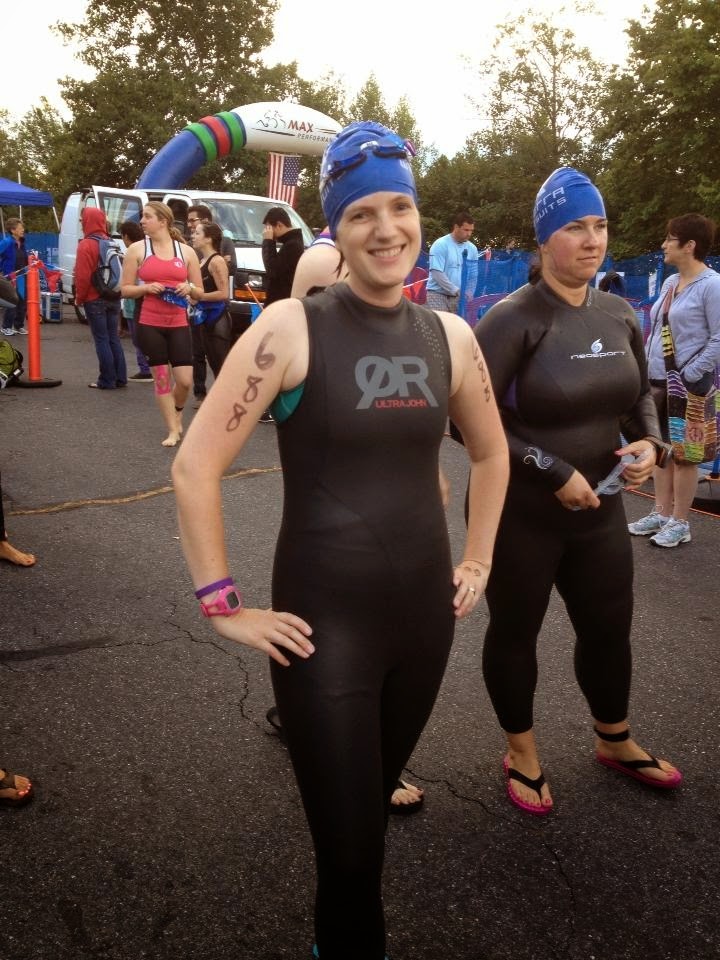Welcome to my first post in our new Tri Talk Tuesday link-up with Courtney at The Trigirl Chronicles and Cynthia at You Signed Up for What. We started this link-up as a place for triathlete bloggers to get together and chat about all things tri. As relatively new triathletes, we all felt like there was a general dearth of free information and support out there for aspiring triathletes. Further, as bloggers, there's not a ton of places in the cyber-world to connect and share experiences. So please, leave your own TriTalk Tuesday link at the bottom of this page!!!
We decided to kick off our link-up with a topic that is on the mind of almost every beginner triathlete (and many seasoned ones, too).
The Swim
This is the leg of the triathlon that seems to generate the most anxiety among new racers. After all, there's a lot to feel apprehensive about. You've got to squeeze your jiggly bits into a speedo or worse, a wetsuit... you've heard stories about being punched and kicked in the start of the race. Furthermore, these swims don't always take place in nice, civilized pools. You have to go out "open water swimming", a phrase that is both baffling and frightening to the uninitiated. Plus, we as land mammals breath air!! Not water!! We're not the Little Mermaid after all! So what to do? Let's take this one step at a time....
1. Getting dressed.
Congrats! You've plucked up the courage, found a pool, and made time to swim. Time to take all you've got and squeeze it into a garment that you've likely not worn voluntarily (or at least, non-grudgingly) since your twenties. Athletic suits are fitted. Meaning no skirts, ruffles, padding or other funny business designed to hide or accentuate whatever part of yourself you think needs it. Deep breath - repeat this phrase:
No one cares what you look like in a swimsuit but you.
Say it once more for good measure. No one cares what I look like in a swimsuit but me. Get a suit that fits, is comfortable, and has no extra what-not to create drag. The old mommy onesie you have in the back of your closet will do. The string bikini that falls off at the slightest turbulence will not. Continue to repeat your mantra as you head to the pool deck. Mind your manners - don't stare at the other swimmers and they won't stare at you. We're all here to do our own thing. It's all good.
2. The actual swimming part.
This is the part I am lest qualified to talk about because frankly, I'm a beginner myself. I took a Total Immersion class that vastly improved my stroke. You can read about it here. Instead I'm going to talk about water anxiety. You may feel like everyone is watching you (they are not). You may feel like the pool is endlessly long and getting to the end of it takes more time and gasping breathes than you can manage, much less for the distance of any triathlon race. My best tips are:
- Breathe. It's amazing how often this gets overlooked. The sensation of anxiety and panic is hard-wired in your brain. When you panic, you feel like you can't breathe. If you are pushing yourself so hard that you can't catch your breath, or you're so focused on the task of maintaining whatever swim mojo you have that you forget to take regular breaths, your brain might start to interpret it as anxiety. Your breath should be steady and natural. Breathe out continuously underwater, then in when you turn to breathe. Even if you have to stop, roll on your back, stand up, what have you - breathe. Breathe more often.
- Breathe on both sides. This doesn't mean breathe every stroke, or even alternating all the time. It means become more or less equally comfortable turning your head to either side to take a breath. In addition to creating troublesome imbalances in your body, always breathing to the same side can leave you choking in a race when waves are coming from your strong side or another swimmer's feet are kicking up water at you. It's just a good habit to get into.
- Relax your head and your neck. Swimming uses almost all the muscle groups in your body. It does NOT use your neck and head. Let those muscles relax and turn to jelly. Shoulders down your back. Head bobbing. The water will support your head, I promise. Check yourself as you move through your training set, as we have a tendency to tense up as we go along. Maintaining a relaxed head and neck will greatly reduce your overall tension, increase your calm, and improve your overall experience in the water.
3. The Open Water Swim
Now you've put in some good laps at the pool. You are confident you can swim continuously (or mostly, pausing for the occasional breather), for a good chunk of time. If you are lucky you live in a climate where ice does not cover your open water training areas for 9 months of the year (grouchy New Englander here). Time to head to the beach or the lake for open water swimming practice.
I really cannot stress enough how important it is to get in as much open water practice as you can before your first race. Especially if you have any qualms about swimming in general, or swimming in the great wide open specifically. It's a totally different experience. It's darker. There are no lines on the bottom of the pool to guide you. You have to "sight" to stay on track. You now share the water with various plants, fish and other critters.
- Let's explore this one a little further. You will share your swimming space with lake plants, which can feel ticklish or grabby. There might be minnows that nibble your toes. A frog might jump. I have been swimming along and startled because a bass nearly hit my goggles. It happens. None of these creatures are going to harm you in any way. Nor is the mud/sand/rocks/pebbles/slime on the bottom harmful either. It just is. Make your peace with it. You have enough to worry about come race day without irrational fears that something is going to eat you.
 |
| This guy does NOT share your swimming space |
- Safety tips. the biggest one is.... Never, EVER swim alone!!!! "Not alone" means having someone swimming in the water with you, or in a kayak next to you, at close enough range that they would notice if you went under. Having your buddy drink sodas on the beach while you swim does not count as being with someone. Most areas have open water groups that will go out together - some investigation and putting yourself forward will hook you up with some new friends to swim with. Plus, as swimming outside designated areas is restricted in many areas, folks that have been doing this a while will help you sort out where and when are the safest places to go. Don't worry that you might be slower or less proficient than your new friends. Triathletes are by nature a gregarious bunch and most understand the importance of OWS, and that folks can't do it alone.
- Grab a buoy. ISHOF SaferSwimmer makes these neat little blow-up bouys that clip around your waist and trail behind you. They make you more visible in the water, and are there if you need to grab onto them and catch your breath. Not just for beginners - anyone can have a cramp! Plus they hold your car keys and your GPS watch.
 |
| http://www.ishof.org/safety/ssd.htm |
4. The wetsuit
Do I need one? Do I not need one? What's the difference between a wetsuit and a trisuit?? How do I put the darn thing on and whaddaya mean they cost at least $200????
 |
| Black is slimming |
On the flip side, wetsuits can feel confining, are hard to get on and hard to get off in transition. If you wore a wetsuit for a sprint triathlon in 90 degree heat you would like give yourself hyperthermia trying to get the blessed thing on you, and quite possibly spend more time trying to get it off in transition than you spent actually in the water. For warm weather, warm water races they are not necessary. If it's your first season and you are on the fence, there are many places that rent them for a day. Try before you buy. Or simply restrict yourself to races that don't need them as you get started.
Oh, and a trisuit is what you wear under your wetsuit and throughout the whole race. You wear the wetsuit over it and only for the swim.
5. The "mass-start"
The craziness of hundreds of swimmers packed together, pushing, kicking and grabbing at each other to reach the front. Swimming in a washing machine. Sounds pretty scary to me!
 |
| This was on Survivor, right? |
Except that this has yet to happen to me. True, I've only done a couple of races. But I've employed a very simple strategy at both to avoid it.
Here it is: 1.....2....3.....4....5....6....7....8....9....10...
There you go. Now most swimmers are ahead of me and I have the water to myself. That ten-count just greatly reduced my anxiety at the start of a race and gave me my own "bubble" in which to swim. I'll make those seconds up later. You can also stand to the side a bit at the start. Don't cluster in at the middle. Don't hug the turn buoys as everyone cuts in there. As you become a more confident swimmer you can go use your elbows. I plan on positioning myself closer to the front and center of my wave in this years races than I did when I was a total newbie. But you have time to get there. Don't let a scary bad swim leg ruin your race.
Another great tool is attending an open-water swim clinic prior to your race. Many tri clubs put them on. I went to one last year sponsored by VMPS. Their coaches walked us all through many aspects of the open water swim, including a drill where we all bunched together and dove in on top of each other to simulate the mass-start. It was tremendously helpful.
 |
| My swim wave at a race last year. Isn't it pretty? |





3 comments:
I was so excited to see that you guys are doing Tri Talk!! I've been back and forth on wanting to do a tri and the hang up is ALWAYS the swim. I can swim, but I'm weird about open water and things touching me. Maybe I'd be less freaked out in a wetsuit.
This post is awesome though and definitely addressed every issue I've ever had, including being eaten by a giant alligator. (Well really I have more of an irrational shark fear, but same general idea.)
Sharks! That's what I'm afraid of. Oh, and the occasional amorous sea lion. That's why I won't swim in the ocean here in California. Luckily there are plenty of lakes and reservoirs to swim in, too.
That personal buoy thing is awesome! I totally want one! I'm getting better about the relaxed neck thing too. I think once I'm in open water and I'm not concerned about head butting the wall I'll be better about not looking up as I swim.
Post a Comment